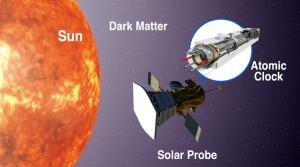Blog
The Dark Matter of Time
9 December 2022
 Kavli IPMU
Kavli IPMUDark matter continues to vex astronomers around the world. We see its effects in the clustering of galaxies and the gravitational lensing of light within galaxies, and it seems to comprise about 80% of the matter in the universe, but we still haven’t detected it on Earth. So what about at least detecting it in our solar system? That might be possible according to a new study in Nature Astronomy.1
The basic idea is simple. If dark matter is throughout the universe, then there must be dark matter throughout our solar system. It should affect things such as the planetary orbits in ways we can measure. The problem is that our observations of planetary motions aren’t precise enough to detect the effects of dark matter. Not even Mercury, the planet that would be most affected by concentrations of dark matter near the Sun, has any measured deviation. So this new work proposes a more precise experiment using atomic clocks.
According to theory, since dark matter interacts with regular matter gravitationally, the dark matter in our solar system should be most concentrated near the Sun, so that is where it would have the greatest effect. So the team proposes putting an atomic clock close to the Sun and having it send a signal to another atomic clock further away. By sending a highly tuned signal between the two, we could measure the gravitational effect in the region, and possibly determine the density of dark matter near the Sun.
The experiment could also test certain dark matter models that argue dark matter is composed of ultralight particles. If true, these particles would interact with electrons in subtle ways, causing their effective mass and interaction strength to vary slightly. This would in turn cause signals from the atomic clocks to have tiny fluctuations, which could also be detectable.
What’s interesting about this idea is that such an experiment could be done with our current engineering abilities. Small, low-powered atomic clocks are readily available, and could easily be placed on spacecraft. And the Parker Solar Probe is already orbiting the Sun within Mercury’s orbit since 2018, and will soon move even closer to the Sun. Undertaking this experiment is a budgetary challenge, not an engineering one.
It may be that the mystery of dark matter won’t be solved any time soon. Far too many experiments have come up null, and we are still not close to understanding the details of its nature. But new experiments such as this one show we have more ideas to explore, and the more we learn the closer we will be to either proving dark matter or proving an alternative theory.
Tsai, Yu-Dai, Joshua Eby, and Marianna S. Safronova. “Direct detection of ultralight dark matter bound to the Sun with space quantum sensors.” Nature Astronomy (2022): 1-9. ↩︎